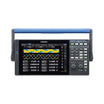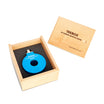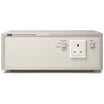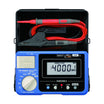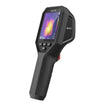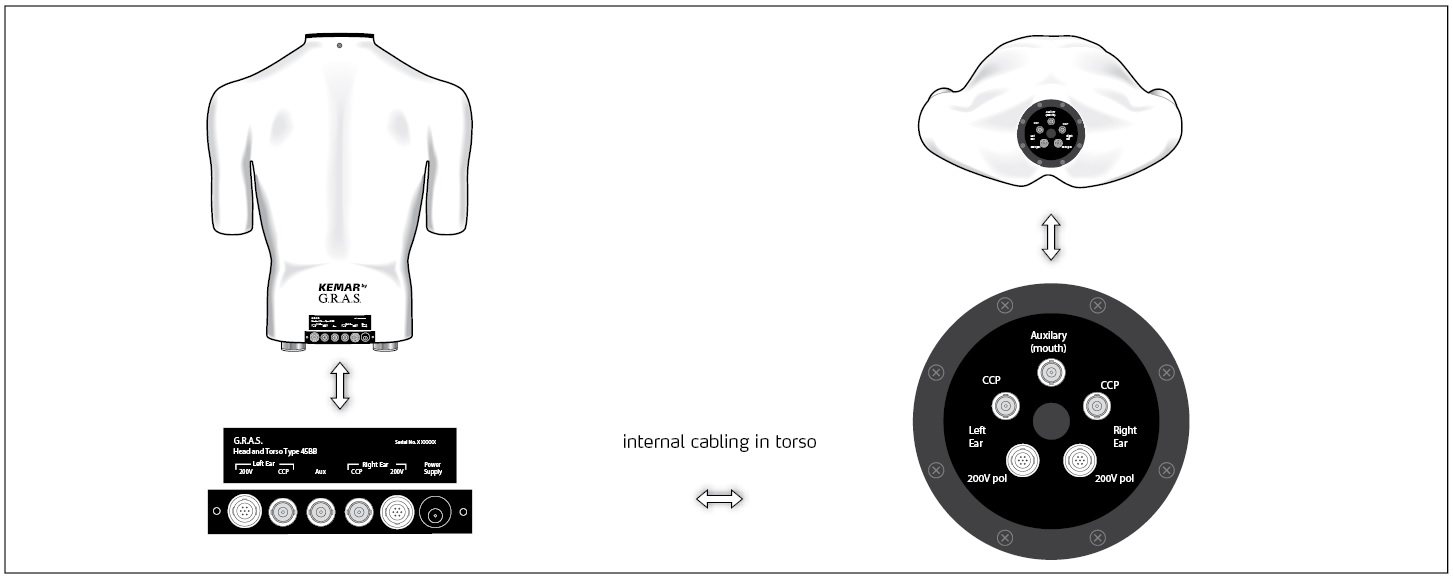
GRAS 45BC KEMAR Head & Torso with Mouth Simulator, Non-configured
Use our chat for personal support or contact us via +45 31 33 18 19 or salg@GOmeasure.dk
The 43BB Low-noise Ear Simulator System is based on the standardized IEC 60318-4 (711) Ear Simulator, but the built-in microphone is the 40AH low-noise microphone which has a specially reduced inherent noise floor in order to achieve a large dynamic range.
Discover the possibilities
More information
Description
GRAS 45BC KEMAR Head & Torso with Mouth Simulator, Non-configured
Introduction
The KEMAR head and torso simulator was introduced by Knowles in 1972 and quickly became the industry standard for hearing-aid manufacturers and research audiologists (visit KEMAR.us to read the full story). The GRAS KEMAR has the same dimensions and acoustical properties as the original KEMAR from 1972 and is 100% backward compatible.When fitted with pinna simulators, ear canal extension, and Ear Simulator, according to IEC 60318-4 or low-noise, KEMAR closely mimics the acoustic properties of the human ear. A KEMAR equipped with a mouth simulator also mimics the properties of the human mouth, and can, therefore, be used for testing of communication devices containing both microphone and loudspeaker. A 45BC KEMAR with mouth simulator has the same acoustical properties as a 45BB KEMAR without mouth simulator, except for a minor difference caused by the 45BC KEMAR's slightly open mouth.
The 45BC KEMAR meets the international standards as specified by IEC: 60318-7 and ANSI: S3.36, S3.25 and is based on ITU-T P 58.
The 45BB KEMAR is identical but without a Mouth Simulator. Read more about 45BB KEMAR here.
Design
Anthropometric Head and Torso
The major difference between KEMAR and the standard commercially available head and torso simulators (HATS) is that KEMAR is built on large statistical research of the average human body – meaning that the KEMAR has the same acoustical properties as an average human, including distinct facial features. Therefore it provides acoustic diffraction similar to that encountered around the median human head and torso, both in the proximity and in the far-field. Because of its anthropometric shape, it does so more realistically than any other manikin. KEMAR is the only manikin with a changeable ear-to-shoulder ratio simulating both male and female median values.Mouth Simulator
The built-in mouth simulator simulates the sound field around the human head at close quarters and the far-field. It is based on ITU-T Rec. P.58. At the mouth reference point (MRP) – 25 mm from the lip plane – the mouth simulator can be equalized to produce a signal from 100 Hz to 10 kHz up to a level of minimum 100 dB re. 20 μPa. The internal amplifier provides 10 dB amplification. If switched off, it is bypassed.Ear Simulators
The IEC 60318-4 Ear Simulator
The GRAS Ear Simulator according to IEC 60318-4 is an ear simulator with an input impedance that closely resembles that of the human ear. It meets the requirements of IEC 60318-4:2007 “Occluded-ear simulator for the measurement of earphones coupled to the ear by ear inserts.” ITU-T P. 57 (08/96) “Series P: Telephone transmission quality, Objective measuring apparatus: Artificial ears.” It embodies a number of carefully designed volumes connected via well-defined and precisely tuned resistive grooves. Its input impedance resembles that of the human ear and therefore it loads the device under test in a way very similar to the human ear. It is delivered in two versions:The Externally Polarized Ear Simulator RA0045 with the GRAS 40AG ½” Ext. Polarized Pressure Microphone. It requires a traditional 200 V polarization voltage. The connection is via 7-pin LEMO.
The Pre-polarized Ear Simulator RA0045-S1 with the GRAS 40AO ½” Prepolarized Pressure Microphone. It requires a CCP supply. The connection is via a BNC cable.
Both are supplied with an individual calibration chart for the coupler-microphone combination.
The 43BB Low-noise Ear Simulator System
The 43BB Low-noise Ear Simulator System is based on the standardized IEC 60318-4 (711) Ear Simulator, but the built-in microphone is the 40AH low-noise microphone which has a specially reduced inherent noise floor in order to achieve a large dynamic range.It has a very low noise floor – below 10.5 dB(A) – and can measure sound levels below or close to the threshold of human hearing. For comparison, a standard IEC 60318-4 (711) ear simulator with a GRAS 40AG 1/2" microphone has its noise floor at 24.2 dB(A).
Read more about the 43BB here.
High-Frequency and Hi-Res Ear Simulators
The standard IEC 60318-4 ear simulator has a steep resonance at 13.5 kHz which makes it difficult to use above 8-10 kHz. For this reason, two IEC 60318-4 compliant/compatible versions with resonance damping have been developed.The IEC 60318-4 compliant high-frequency version extends the useful frequency range to 20 kHz. It comes in two versions: The Externally Polarized Ear Simulator RA0401 with the GRAS 40AG ½” Ext. Polarized Pressure Microphone. It requires a traditional 200 V polarization voltage. The connection is via 7-pin LEMO, and the Pre-polarized Ear Simulator RA0402 with the GRAS 40AO ½” Prepolarized Pressure Microphone. It requires a CCP supply. The connection is via a BNC cable.
The IEC 60318-4 compatible Hi-Res version extends the useful frequency range to 50 kHz. It comes in two versions: The Externally Polarized Ear Simulator RA0403 with the GRAS GRAS 40BP 1/4” Ext. Polarized Pressure Microphone. It requires a traditional 200 V polarization voltage. The connection is via 7-pin LEMO, and the pre-polarized Ear Simulator RA0404 with the GRAS GRAS 40BD 1/4” Prepolarized Pressure Microphone. It requires a CCP supply. The connection is via a BNC cable.
Pinnae - Standardized or Anthropometric
Standardized pinnaeTwelve (six pairs) different types of standardized pinnae are available for KEMAR. They come in two sizes (standard and small), normal or soft (normal: 55 Shore OO (IEC 60959) and soft: 35 Shore OO), and a VA-style (55 Shore OO or 35 Shore OO). They are designed for an easy push-fit into the ear recesses on the sides of the KEMAR Head.
Anthropometric pinnae
In addition to the standardized pinnae, anthropometric pinnae for KEMAR are available. They have anatomically correct ear-entrance and ear-canal with correct soft ear helix and provide perfect sealing and insertion accuracy for headphones and earphones, and improved collapsibility when testing supra- and circum-aural headsets. The hardness is 35 Shore OO.
Read more about the anthropometric pinna here.
Ear Canal Extensions
GRAS ear canal extensions are made of steel or POM and will not deform when testing devices in the concha or devices that are pressed against the pinnae, for example telephone handsets and earphones. This ensures an ultimate interface to the IEC 60318-4 Ear Simulator, resulting in a high degree of repeatability. For testing of binaural hearing aids, ear canal extensions made of POM must be used.| GRAS RA0237 | Ear Canal Extension Kit with standard pinna-extension tube, Ø 7.5 mm, 8.3 mm long. Standardized according to IEC60318-7. 2 pcs, O-rings included. |
| GRAS RA0238 | Ear Canal Extension Kit with tapered pinna-extension tube. Ø 9.85 tapering down to Ø 7.5 mm, 7.4 mm long. 2 pcs, O-rings included. |
| GRAS RA0239 | Ear Canal Extension Kit with silicone rubber lining, Ø 7.5 mm, 14 mm long. Standardized according to ANSI S12.42. 2 pcs, O-rings included. |
| GRAS RA0249 | Straight Earl Canal Extension Kit for KEMAR, Ø 7.5 mm, 8.3 mm long. Made of POM*. Standardized according to IEC60318-7. 2 pcs. O-rings are included. |
| GRAS RA0250 | Tapered Ear Canal Extension Kit for KEMAR. Made of POM*. Ø 9.85 tapering down to Ø 7.5 mm, 7.4 mm long. 2 pcs. O-rings are included. |
*To obtain the desired effect of non-interference with RF communication inside the head, KEMAR must also be fitted with plastic ear holder plates. These are part of the GRAS RA0251 Retrofit Kit for Binaural Hearing Aid Test. This kit also contains the RA0249 and RA0250 Ear Canal Extensions.
The ear canal extensions are for use with the standard pinnae. The anthropometric pinnae seal directly against the ear simulator.
True to the Legacy - but Improved
The current KEMAR has the same dimensions and acoustical properties as the original KEMAR, but has been developed further by GRAS to meet the industry’s demand for realistic measurements. Today, more than 40 years after its inception, KEMAR can test any device that contains both loudspeakers and microphones as well as perform binaural recordings of product sound and music.At GRAS we safeguard KEMAR's legacy, but are also continuously expanding the range of features and functionalities leading to new applications and uses - without compromising KEMAR's original form.
In 2013, KEMAR underwent a substantial rejuvenation that introduced major improvements to build quality, user-friendliness and configurability. KEMAR’s previous fiberglass construction was updated to a plastic composite that provides a more user-friendly and rugged construction. At the same time, many other improvements were introduced, making KEMAR much easier to configure, calibrate and service.
Ease of Use
The improvements to KEMAR's user-friendliness comprise:- The interior of KEMAR's head can be accessed easily by pushing a button and lifting the scalp.
- The transducers are mounted and removed by a simple snap-fit mechanism.
- Standard pinnae are push mounted from the outside. The anthropometric pinnae, however, are secured from the inside by two screws in addition to the push mounting.
- A scale around KEMAR's neck indicates the head angle and allows for repeatable measurements.
In most cases, calibration can be done from the outside without dismantling the ear simulator(s). However, for some configurations - with microphones and anthropometric pinnae - dismounting of the transducers before calibration is necessary.
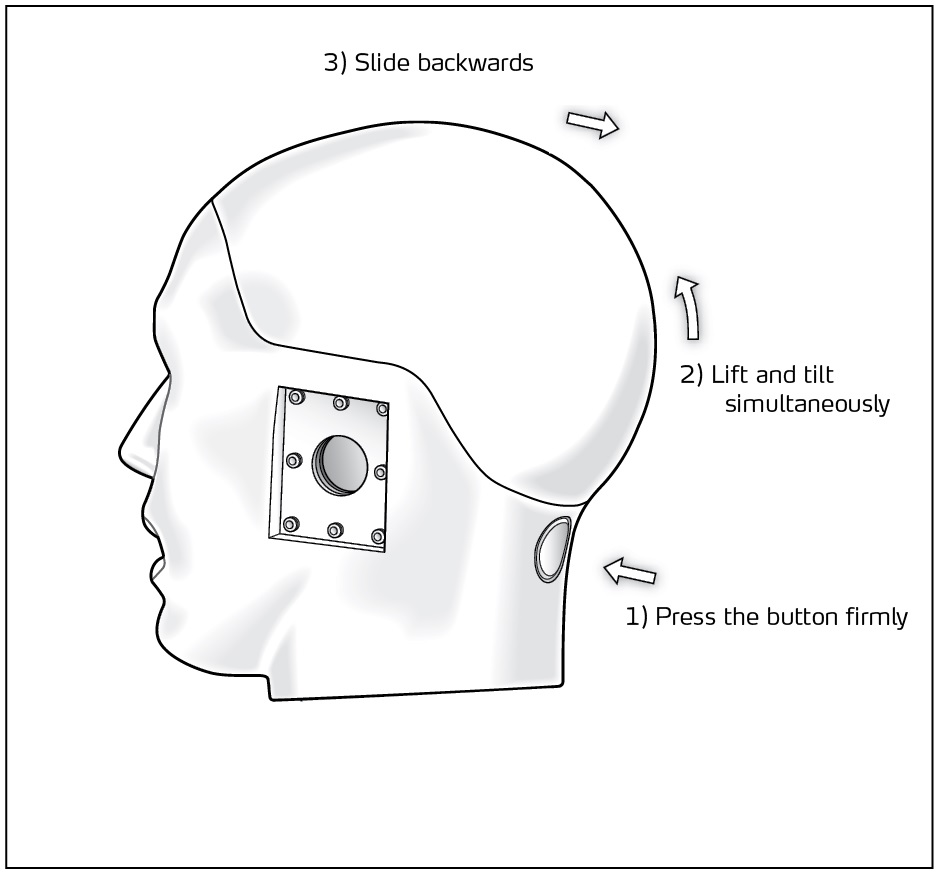
The interior of KEMAR's head can be accessed easily by pushing a button and lifting the scalp.
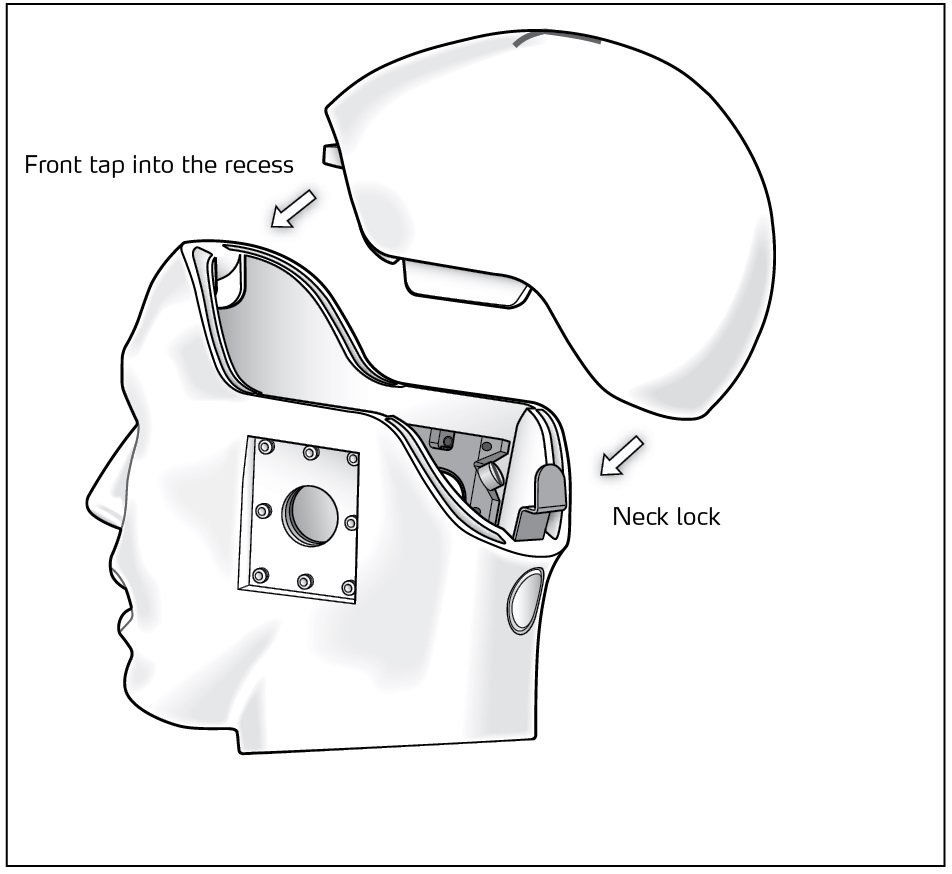
Mounting the neck is a simple push fit.

The transducers are mounted and removed by a simple snap fit mechanism.

A scale around KEMAR's neck indicates the head angle and allows for repeatable measurements.
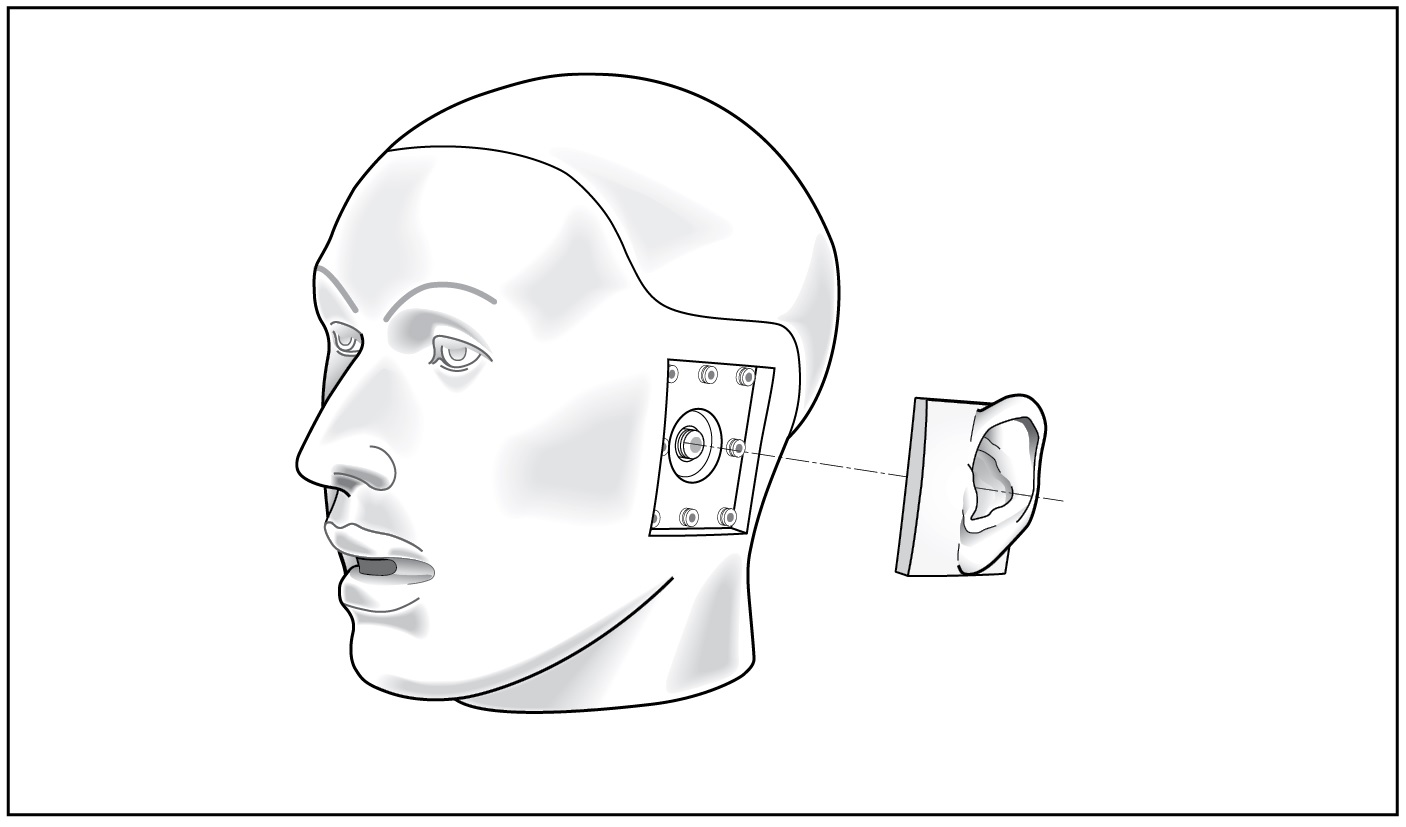
Standard pinnae are push mounted from the outside. The anthropometric pinnae, however, are secured from the inside by two screws in addition to the push mounting.

In most cases calibration can be done from the outside without dismantling the ear simulator(s).
Cabling and Connections
All internal cabling is factory mounted. The sockets for connection to ear simulators or microphones are easily accessible at the top of the neck, the sockets for connection to instrumentation are located at the lower back.Mounting Options
KEMAR is delivered with two tripod adapters, one for tripods with 3/8” thread and one for ø35 mm loudspeaker stands.Typical Applications and Use
A Multi-configurable Test Tool
The 45BC KEMAR Head and Torso, non-configured is a KEMAR without any application-specific accessories. As such, this KEMAR is intended for customers who want to reuse accessories already in their possession. But the non-configured KEMAR is also the core of all configured 45BC KEMARs.The main application-specific accessories are:
- 60318-4 ear simulators, both externally polarized and prepolarized
- A low-noise ear simulation system, externally polarized
- ½ inch or ¼ inch. microphones, externally polarized and prepolarized
- Preamplifiers selected to match the actual configuration
- Straight and conical ear canal extensions, made from steel
- Straight and conical ear canal extensions, made from POM
- 12 different standard pinnae, small and large, soft and normal, straight or VA-style
- 2 anthropometric pinnae, with anthropometric concha and ear canal.
- A mouth simulator with a built-in power amplifier.
With these accessories, KEMAR can be configured for a wide range of both standard and special applications, making it the most versatile manikin for in-situ anthropometric testing today.
KEMAR is used in various industries around the world and is the recognized industry-standard for in-situ anthropomorphic testing in the fields of:
- Hearing aid testing
- Ear and headphone testing
- Sound recording and sound-quality evaluation
- Headset and telephone testing
- Testing of active noise cancellation systems
A number of pre-configured KEMARs with mouth simulator are available. Each configuration is optimized for a specific application, with transducer(s), preamplifiers, pinna simulators, and cables and accessories. They are delivered fully assembled, tested and calibrated as complete out-of-the-box systems. These are:
Headset Testing
For headset testing, 6 different configurations are available.45BC-1 and 2 for Headset Test
For testing headsets with 60318-4 ear simulators and standardized pinnae, a LEMO version and a CCP version are available. They are configured with 60318-4 ear simulators and large pinnae 55 Shore OO. These two configurations are for testing in accordance with the relevant standards.
GRAS 45BC-1 KEMAR for Headset Test, 2-Ch LEMO
GRAS 45BC-2 KEMAR for Headset Test, 2-Ch CCP
45BC-9 and 10 for Headset Test with Anthropometric Pinnae
For headset testing with anthropometric pinnae, two configurations with 60318-4 ear simulators and anthropometric pinnae are available. The anthropometric pinnae introduce a number of advantages over the standardized pinnae when testing insert types of transducers and supra-aural headsets. With the anthropometric pinnae, you get improved fit, seal and repeatability when testing in-ear devices and more realistic collapsibility when testing supra and circum-aural devices.
GRAS 45BC-9 KEMAR with Mouth Simulator and Anthropometric Pinnae for Headset Test, 2-Ch LEMO
GRAS 45BC-10 KEMAR with Mouth Simulator and Anthropometric Pinnae for Headset Test, 2-Ch CCP
45BC-11 and 12 for Low-noise Headset Test
For low-noise testing of ear and headphones, two configurations with low-noise ear simulator system(s) and anthropometric pinnae are available, both for single-channel and dual-channel testing. The combination of a special low-noise version of the ear simulator and the anthropometric pinnae introduces major improvements to fit, accuracy and, repeatability. Also, the low- and high-frequency performance is improved when testing insert type ear and headphones. This KEMAR can also test at or below the threshold of human hearing. The low-noise artificial ear is available in a LEMO version only.
GRAS 45BC-11 KEMAR with Mouth Simulator and Anthropometric Pinnae for Low-noise Headset Test, 1-Ch LEMO
GRAS 45BC-12 KEMAR with Mouth Simulator and Anthropometric Pinnae for Low-noise Headset Test, 2-Ch LEMO
45BC-13 and 14 for High-frequency Testing of Headsets
For testing of headsets, a KEMAR configured with high-frequency ear simulators and anthropometric pinnae 35 Shore OO is available. The high-frequency ear simulators extend the useful frequency range to 20 kHz. Both a LEMO and a CCP version are available. The anthropometric pinnae introduce better fit and repeatability when testing anthropometrically shaped insert types of ear and headphones. Read more here:
GRAS 45BC-13 KEMAR for High-Frequency Test of Headsets, 2-Ch LEMO
GRAS 45BC-14 KEMAR for High-Frequency Test of Headsets, 2-Ch CCP
45BC-15 and 16 for Hi-Res Testing of Headsets
For testing of headsets, a KEMAR configured with hi-res ear simulators and anthropometric pinnae 35 Shore OO is available. The hi-res ear simulators extend the useful frequency range to 50 kHz. Both a LEMO and a CCP version are available. The anthropometric pinnae introduce better fit and repeatability when testing anthropometrically shaped insert types of ear and headphones. Read more here:
GRAS 45BC-15 KEMAR for High-Frequency Test of Headsets, 2-Ch LEMO
GRAS 45BC-16 KEMAR for High-Frequency Test of Headsets, 2-Ch CCP
Telephone Testing
For telephone test, two configurations with the45EA Handset Positioning System are available. With this, very realistic in-situ measurements on mobile telephones as well as conventional handsets are possible.GRAS 45BC-3 KEMAR for Telephone Test, 1-Ch LEMO
GRAS 45BC-4 KEMAR for Telephone Test, 1-Ch CCP
KEMAR without Mouth Simulator
The 45BB KEMAR is a KEMAR without Mouth Simulator. 16 different configurations are available. Read more here.Performance and Warranty
KEMAR is made of components from our standard portfolio, all manufactured of high-quality material and branded parts that were chosen and processed to ensure life-long stability and robustness. This enables us to offer 2 years warranty against defective materials and workmanship.Exceptions: Microphones included in KEMAR as for these our normal 5-year warranty apply. The warranty period for cables is 6 months.
Specifications
Documents
GRAS 45BC KEMAR Head & Torso with Mouth Simulator, Non-configured
GRAS 45BC KEMAR Head & Torso with Mouth Simulator, Non-configured datasheetOptions
Video
GRAS 45BC KEMAR Head & Torso with Mouth Simulator, Non-configured
Introduction
The KEMAR head and torso simulator was introduced by Knowles in 1972 and quickly became the industry standard for hearing-aid manufacturers and research audiologists (visit KEMAR.us to read the full story). The GRAS KEMAR has the same dimensions and acoustical properties as the original KEMAR from 1972 and is 100% backward compatible.When fitted with pinna simulators, ear canal extension, and Ear Simulator, according to IEC 60318-4 or low-noise, KEMAR closely mimics the acoustic properties of the human ear. A KEMAR equipped with a mouth simulator also mimics the properties of the human mouth, and can, therefore, be used for testing of communication devices containing both microphone and loudspeaker. A 45BC KEMAR with mouth simulator has the same acoustical properties as a 45BB KEMAR without mouth simulator, except for a minor difference caused by the 45BC KEMAR's slightly open mouth.
The 45BC KEMAR meets the international standards as specified by IEC: 60318-7 and ANSI: S3.36, S3.25 and is based on ITU-T P 58.
The 45BB KEMAR is identical but without a Mouth Simulator. Read more about 45BB KEMAR here.
Design
Anthropometric Head and Torso
The major difference between KEMAR and the standard commercially available head and torso simulators (HATS) is that KEMAR is built on large statistical research of the average human body – meaning that the KEMAR has the same acoustical properties as an average human, including distinct facial features. Therefore it provides acoustic diffraction similar to that encountered around the median human head and torso, both in the proximity and in the far-field. Because of its anthropometric shape, it does so more realistically than any other manikin. KEMAR is the only manikin with a changeable ear-to-shoulder ratio simulating both male and female median values.Mouth Simulator
The built-in mouth simulator simulates the sound field around the human head at close quarters and the far-field. It is based on ITU-T Rec. P.58. At the mouth reference point (MRP) – 25 mm from the lip plane – the mouth simulator can be equalized to produce a signal from 100 Hz to 10 kHz up to a level of minimum 100 dB re. 20 μPa. The internal amplifier provides 10 dB amplification. If switched off, it is bypassed.Ear Simulators
The IEC 60318-4 Ear Simulator
The GRAS Ear Simulator according to IEC 60318-4 is an ear simulator with an input impedance that closely resembles that of the human ear. It meets the requirements of IEC 60318-4:2007 “Occluded-ear simulator for the measurement of earphones coupled to the ear by ear inserts.” ITU-T P. 57 (08/96) “Series P: Telephone transmission quality, Objective measuring apparatus: Artificial ears.” It embodies a number of carefully designed volumes connected via well-defined and precisely tuned resistive grooves. Its input impedance resembles that of the human ear and therefore it loads the device under test in a way very similar to the human ear. It is delivered in two versions:The Externally Polarized Ear Simulator RA0045 with the GRAS 40AG ½” Ext. Polarized Pressure Microphone. It requires a traditional 200 V polarization voltage. The connection is via 7-pin LEMO.
The Pre-polarized Ear Simulator RA0045-S1 with the GRAS 40AO ½” Prepolarized Pressure Microphone. It requires a CCP supply. The connection is via a BNC cable.
Both are supplied with an individual calibration chart for the coupler-microphone combination.
The 43BB Low-noise Ear Simulator System
The 43BB Low-noise Ear Simulator System is based on the standardized IEC 60318-4 (711) Ear Simulator, but the built-in microphone is the 40AH low-noise microphone which has a specially reduced inherent noise floor in order to achieve a large dynamic range.It has a very low noise floor – below 10.5 dB(A) – and can measure sound levels below or close to the threshold of human hearing. For comparison, a standard IEC 60318-4 (711) ear simulator with a GRAS 40AG 1/2" microphone has its noise floor at 24.2 dB(A).
Read more about the 43BB here.
High-Frequency and Hi-Res Ear Simulators
The standard IEC 60318-4 ear simulator has a steep resonance at 13.5 kHz which makes it difficult to use above 8-10 kHz. For this reason, two IEC 60318-4 compliant/compatible versions with resonance damping have been developed.The IEC 60318-4 compliant high-frequency version extends the useful frequency range to 20 kHz. It comes in two versions: The Externally Polarized Ear Simulator RA0401 with the GRAS 40AG ½” Ext. Polarized Pressure Microphone. It requires a traditional 200 V polarization voltage. The connection is via 7-pin LEMO, and the Pre-polarized Ear Simulator RA0402 with the GRAS 40AO ½” Prepolarized Pressure Microphone. It requires a CCP supply. The connection is via a BNC cable.
The IEC 60318-4 compatible Hi-Res version extends the useful frequency range to 50 kHz. It comes in two versions: The Externally Polarized Ear Simulator RA0403 with the GRAS GRAS 40BP 1/4” Ext. Polarized Pressure Microphone. It requires a traditional 200 V polarization voltage. The connection is via 7-pin LEMO, and the pre-polarized Ear Simulator RA0404 with the GRAS GRAS 40BD 1/4” Prepolarized Pressure Microphone. It requires a CCP supply. The connection is via a BNC cable.
Pinnae - Standardized or Anthropometric
Standardized pinnaeTwelve (six pairs) different types of standardized pinnae are available for KEMAR. They come in two sizes (standard and small), normal or soft (normal: 55 Shore OO (IEC 60959) and soft: 35 Shore OO), and a VA-style (55 Shore OO or 35 Shore OO). They are designed for an easy push-fit into the ear recesses on the sides of the KEMAR Head.
Anthropometric pinnae
In addition to the standardized pinnae, anthropometric pinnae for KEMAR are available. They have anatomically correct ear-entrance and ear-canal with correct soft ear helix and provide perfect sealing and insertion accuracy for headphones and earphones, and improved collapsibility when testing supra- and circum-aural headsets. The hardness is 35 Shore OO.
Read more about the anthropometric pinna here.
Ear Canal Extensions
GRAS ear canal extensions are made of steel or POM and will not deform when testing devices in the concha or devices that are pressed against the pinnae, for example telephone handsets and earphones. This ensures an ultimate interface to the IEC 60318-4 Ear Simulator, resulting in a high degree of repeatability. For testing of binaural hearing aids, ear canal extensions made of POM must be used.| GRAS RA0237 | Ear Canal Extension Kit with standard pinna-extension tube, Ø 7.5 mm, 8.3 mm long. Standardized according to IEC60318-7. 2 pcs, O-rings included. |
| GRAS RA0238 | Ear Canal Extension Kit with tapered pinna-extension tube. Ø 9.85 tapering down to Ø 7.5 mm, 7.4 mm long. 2 pcs, O-rings included. |
| GRAS RA0239 | Ear Canal Extension Kit with silicone rubber lining, Ø 7.5 mm, 14 mm long. Standardized according to ANSI S12.42. 2 pcs, O-rings included. |
| GRAS RA0249 | Straight Earl Canal Extension Kit for KEMAR, Ø 7.5 mm, 8.3 mm long. Made of POM*. Standardized according to IEC60318-7. 2 pcs. O-rings are included. |
| GRAS RA0250 | Tapered Ear Canal Extension Kit for KEMAR. Made of POM*. Ø 9.85 tapering down to Ø 7.5 mm, 7.4 mm long. 2 pcs. O-rings are included. |
*To obtain the desired effect of non-interference with RF communication inside the head, KEMAR must also be fitted with plastic ear holder plates. These are part of the GRAS RA0251 Retrofit Kit for Binaural Hearing Aid Test. This kit also contains the RA0249 and RA0250 Ear Canal Extensions.
The ear canal extensions are for use with the standard pinnae. The anthropometric pinnae seal directly against the ear simulator.
True to the Legacy - but Improved
The current KEMAR has the same dimensions and acoustical properties as the original KEMAR, but has been developed further by GRAS to meet the industry’s demand for realistic measurements. Today, more than 40 years after its inception, KEMAR can test any device that contains both loudspeakers and microphones as well as perform binaural recordings of product sound and music.At GRAS we safeguard KEMAR's legacy, but are also continuously expanding the range of features and functionalities leading to new applications and uses - without compromising KEMAR's original form.
In 2013, KEMAR underwent a substantial rejuvenation that introduced major improvements to build quality, user-friendliness and configurability. KEMAR’s previous fiberglass construction was updated to a plastic composite that provides a more user-friendly and rugged construction. At the same time, many other improvements were introduced, making KEMAR much easier to configure, calibrate and service.
Ease of Use
The improvements to KEMAR's user-friendliness comprise:- The interior of KEMAR's head can be accessed easily by pushing a button and lifting the scalp.
- The transducers are mounted and removed by a simple snap-fit mechanism.
- Standard pinnae are push mounted from the outside. The anthropometric pinnae, however, are secured from the inside by two screws in addition to the push mounting.
- A scale around KEMAR's neck indicates the head angle and allows for repeatable measurements.
In most cases, calibration can be done from the outside without dismantling the ear simulator(s). However, for some configurations - with microphones and anthropometric pinnae - dismounting of the transducers before calibration is necessary.

The interior of KEMAR's head can be accessed easily by pushing a button and lifting the scalp.

Mounting the neck is a simple push fit.

The transducers are mounted and removed by a simple snap fit mechanism.

A scale around KEMAR's neck indicates the head angle and allows for repeatable measurements.

Standard pinnae are push mounted from the outside. The anthropometric pinnae, however, are secured from the inside by two screws in addition to the push mounting.

In most cases calibration can be done from the outside without dismantling the ear simulator(s).
Cabling and Connections
All internal cabling is factory mounted. The sockets for connection to ear simulators or microphones are easily accessible at the top of the neck, the sockets for connection to instrumentation are located at the lower back.Mounting Options
KEMAR is delivered with two tripod adapters, one for tripods with 3/8” thread and one for ø35 mm loudspeaker stands.Typical Applications and Use
A Multi-configurable Test Tool
The 45BC KEMAR Head and Torso, non-configured is a KEMAR without any application-specific accessories. As such, this KEMAR is intended for customers who want to reuse accessories already in their possession. But the non-configured KEMAR is also the core of all configured 45BC KEMARs.The main application-specific accessories are:
- 60318-4 ear simulators, both externally polarized and prepolarized
- A low-noise ear simulation system, externally polarized
- ½ inch or ¼ inch. microphones, externally polarized and prepolarized
- Preamplifiers selected to match the actual configuration
- Straight and conical ear canal extensions, made from steel
- Straight and conical ear canal extensions, made from POM
- 12 different standard pinnae, small and large, soft and normal, straight or VA-style
- 2 anthropometric pinnae, with anthropometric concha and ear canal.
- A mouth simulator with a built-in power amplifier.
With these accessories, KEMAR can be configured for a wide range of both standard and special applications, making it the most versatile manikin for in-situ anthropometric testing today.
KEMAR is used in various industries around the world and is the recognized industry-standard for in-situ anthropomorphic testing in the fields of:
- Hearing aid testing
- Ear and headphone testing
- Sound recording and sound-quality evaluation
- Headset and telephone testing
- Testing of active noise cancellation systems
A number of pre-configured KEMARs with mouth simulator are available. Each configuration is optimized for a specific application, with transducer(s), preamplifiers, pinna simulators, and cables and accessories. They are delivered fully assembled, tested and calibrated as complete out-of-the-box systems. These are:
Headset Testing
For headset testing, 6 different configurations are available.45BC-1 and 2 for Headset Test
For testing headsets with 60318-4 ear simulators and standardized pinnae, a LEMO version and a CCP version are available. They are configured with 60318-4 ear simulators and large pinnae 55 Shore OO. These two configurations are for testing in accordance with the relevant standards.
GRAS 45BC-1 KEMAR for Headset Test, 2-Ch LEMO
GRAS 45BC-2 KEMAR for Headset Test, 2-Ch CCP
45BC-9 and 10 for Headset Test with Anthropometric Pinnae
For headset testing with anthropometric pinnae, two configurations with 60318-4 ear simulators and anthropometric pinnae are available. The anthropometric pinnae introduce a number of advantages over the standardized pinnae when testing insert types of transducers and supra-aural headsets. With the anthropometric pinnae, you get improved fit, seal and repeatability when testing in-ear devices and more realistic collapsibility when testing supra and circum-aural devices.
GRAS 45BC-9 KEMAR with Mouth Simulator and Anthropometric Pinnae for Headset Test, 2-Ch LEMO
GRAS 45BC-10 KEMAR with Mouth Simulator and Anthropometric Pinnae for Headset Test, 2-Ch CCP
45BC-11 and 12 for Low-noise Headset Test
For low-noise testing of ear and headphones, two configurations with low-noise ear simulator system(s) and anthropometric pinnae are available, both for single-channel and dual-channel testing. The combination of a special low-noise version of the ear simulator and the anthropometric pinnae introduces major improvements to fit, accuracy and, repeatability. Also, the low- and high-frequency performance is improved when testing insert type ear and headphones. This KEMAR can also test at or below the threshold of human hearing. The low-noise artificial ear is available in a LEMO version only.
GRAS 45BC-11 KEMAR with Mouth Simulator and Anthropometric Pinnae for Low-noise Headset Test, 1-Ch LEMO
GRAS 45BC-12 KEMAR with Mouth Simulator and Anthropometric Pinnae for Low-noise Headset Test, 2-Ch LEMO
45BC-13 and 14 for High-frequency Testing of Headsets
For testing of headsets, a KEMAR configured with high-frequency ear simulators and anthropometric pinnae 35 Shore OO is available. The high-frequency ear simulators extend the useful frequency range to 20 kHz. Both a LEMO and a CCP version are available. The anthropometric pinnae introduce better fit and repeatability when testing anthropometrically shaped insert types of ear and headphones. Read more here:
GRAS 45BC-13 KEMAR for High-Frequency Test of Headsets, 2-Ch LEMO
GRAS 45BC-14 KEMAR for High-Frequency Test of Headsets, 2-Ch CCP
45BC-15 and 16 for Hi-Res Testing of Headsets
For testing of headsets, a KEMAR configured with hi-res ear simulators and anthropometric pinnae 35 Shore OO is available. The hi-res ear simulators extend the useful frequency range to 50 kHz. Both a LEMO and a CCP version are available. The anthropometric pinnae introduce better fit and repeatability when testing anthropometrically shaped insert types of ear and headphones. Read more here:
GRAS 45BC-15 KEMAR for High-Frequency Test of Headsets, 2-Ch LEMO
GRAS 45BC-16 KEMAR for High-Frequency Test of Headsets, 2-Ch CCP
Telephone Testing
For telephone test, two configurations with the45EA Handset Positioning System are available. With this, very realistic in-situ measurements on mobile telephones as well as conventional handsets are possible.GRAS 45BC-3 KEMAR for Telephone Test, 1-Ch LEMO
GRAS 45BC-4 KEMAR for Telephone Test, 1-Ch CCP
KEMAR without Mouth Simulator
The 45BB KEMAR is a KEMAR without Mouth Simulator. 16 different configurations are available. Read more here.Performance and Warranty
KEMAR is made of components from our standard portfolio, all manufactured of high-quality material and branded parts that were chosen and processed to ensure life-long stability and robustness. This enables us to offer 2 years warranty against defective materials and workmanship.Exceptions: Microphones included in KEMAR as for these our normal 5-year warranty apply. The warranty period for cables is 6 months.


